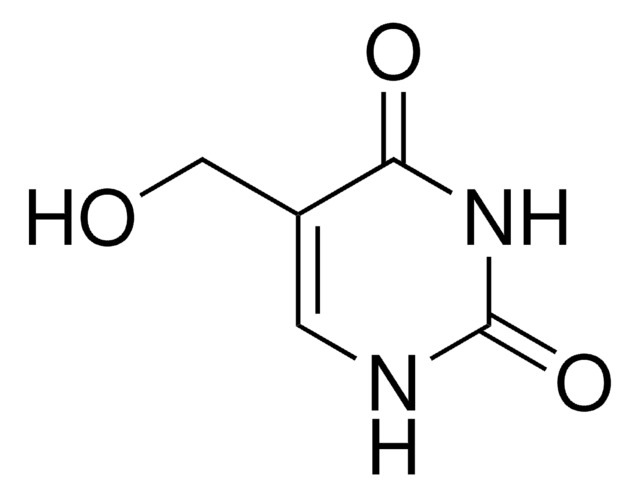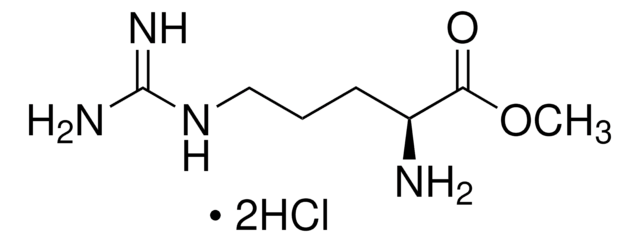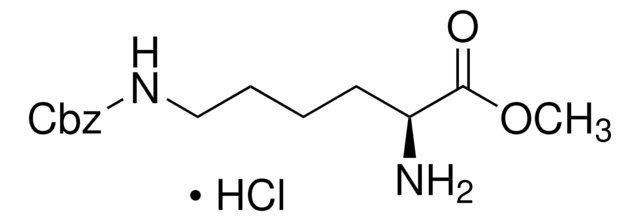859095
Nα-Acetyl-L-lysine methyl ester hydrochloride
98%
Sign Into View Organizational & Contract Pricing
All Photos(1)
About This Item
Linear Formula:
H2N(CH2)4CH(NHCOCH3)CO2CH3·HCl
CAS Number:
Molecular Weight:
238.71
EC Number:
MDL number:
UNSPSC Code:
12352209
PubChem Substance ID:
NACRES:
NA.22
Recommended Products
Quality Level
Assay
98%
form
powder
optical activity
[α]22/D −18°, c = 10 in 6 M HCl
reaction suitability
reaction type: solution phase peptide synthesis
mp
108-114 °C (lit.)
application(s)
peptide synthesis
SMILES string
Cl.COC(=O)[C@H](CCCCN)NC(C)=O
InChI
1S/C9H18N2O3.ClH/c1-7(12)11-8(9(13)14-2)5-3-4-6-10;/h8H,3-6,10H2,1-2H3,(H,11,12);1H/t8-;/m0./s1
InChI key
PCHGTXYLEAQWOM-QRPNPIFTSA-N
Looking for similar products? Visit Product Comparison Guide
Storage Class Code
11 - Combustible Solids
WGK
WGK 3
Flash Point(F)
Not applicable
Flash Point(C)
Not applicable
Choose from one of the most recent versions:
Already Own This Product?
Find documentation for the products that you have recently purchased in the Document Library.
Customers Also Viewed
Xiaoyun Xu et al.
Journal of the American Chemical Society, 130(2), 703-709 (2007-12-18)
The reaction between N(alpha)-acetyllysine methyl ester (Lys) and 2'-deoxyguanosine (dGuo) was used to study structural aspects of DNA-protein cross-link (DPC) formation. The precise structure of DPCs depended on the nature of the oxidant and cross-linking reactions in which a series
S J George et al.
Journal of vascular research, 38(5), 492-501 (2001-09-19)
The focus of this study was identification of the contribution of the plasminogen activator-plasmin system to smooth muscle cell proliferation and migration in human saphenous vein. Segments of human saphenous vein were grown in organ culture for up to 14
Sarah J George et al.
Journal of vascular research, 42(3), 247-254 (2005-05-05)
The effect of activation of endogenous transforming growth factor-beta (TGF-beta) on smooth muscle cell apoptosis was assessed in human saphenous vein. Segments of human saphenous vein, obtained at the time of bypass graft surgery, were cultured for 14 days. During
P K Anonick et al.
Arteriosclerosis and thrombosis : a journal of vascular biology, 12(6), 708-716 (1992-06-01)
alpha-N-acetyl-L-lysine methyl ester (NALME) is a lysine analogue that reportedly binds to low-affinity lysine binding sites in plasmin(ogen) and miniplasmin(ogen). In the studies presented here, we show that NALME has antifibrinolytic activity; however, unlike the therapeutic agents epsilon-amino-n-caproic acid (epsilon
H Nakayama et al.
Journal of immunological methods, 140(1), 119-125 (1991-06-24)
Antibodies directed against advanced glycosylation end products (AGEs) formed during a Maillard reaction have been generated and characterized. Since protein-bound AGEs recognized by the antibodies were labile to acid hydrolysis, the antibodies were further characterized by using the AGE-alpha-acetyl-L-lysine methyl
Our team of scientists has experience in all areas of research including Life Science, Material Science, Chemical Synthesis, Chromatography, Analytical and many others.
Contact Technical Service













